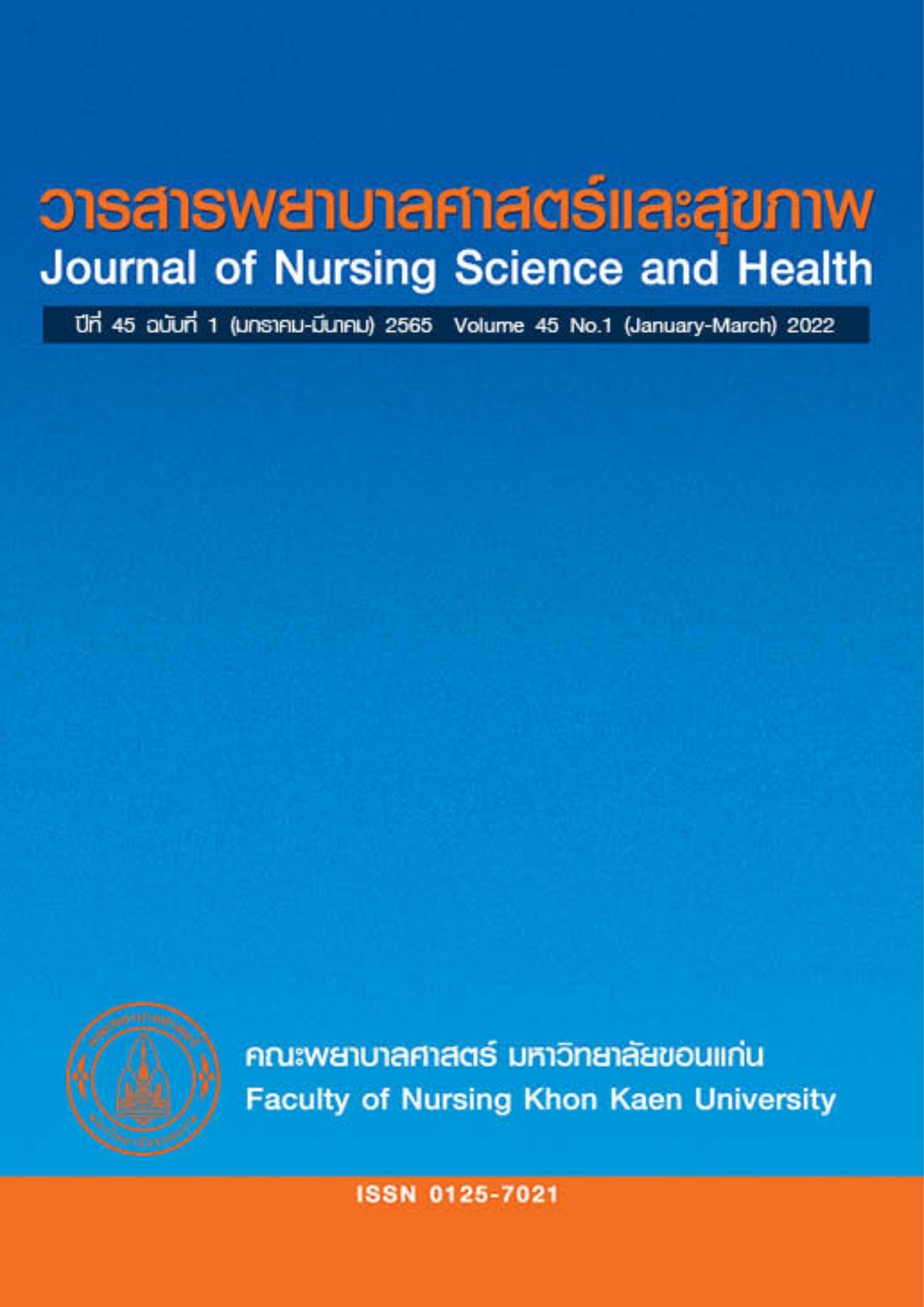การพยาบาลผู้ป่วยหลังผ่าตัดใส่สายระบายปัสสาวะผ่านผิวหนังเข้ากรวยไต รักษาภาวะอุดกั้นระบบทางเดินปัสสาวะ
คำสำคัญ:
สายระบายปัสสาวะผ่านผิวหนังเข้ากรวยไต, ภาวะอุดกั้นระบบปัสสาวะ, การพยาบาลบทคัดย่อ
การผ่าตัดใส่สายระบายปัสสาวะผ่านผิวหนังเข้ากรวยไต (percutaneous nephrostomy: PCN) รักษาผู้ป่วยที่เกิดภาวะอุดกั้นระบบทางเดินปัสสาวะ เป็นการรักษาสำคัญที่ช่วยระบายน้ำปัสสาวะออกจากร่างกาย เพื่อรักษาสมดุลน้ำและเกลือแร่ของร่างกาย พยาบาลมีบทบาทสำคัญอย่างมากในการดูแลผู้ป่วยหลังผ่าตัด ตั้งแต่การสังเกต
อาการอย่างใกล้ชิด ประเมินปัญหาและเฝ้าระวังภาวะแทรกซ้อนที่เป็นอันตราย บทความนี้จึงขอนำเสนอการพยาบาลผู้ป่วยหลังผ่าตัดใส่สายระบายปัสสาวะผ่านผิวหนังเข้ากรวยไตรักษาภาวะอุดกั้นระบบปัสสาวะ โดยการศึกษาจากผู้ป่วยที่เข้ารับการรักษาในโรงพยาบาลศิริราช จำนวน 1 ราย ในช่วงเดือน ตุลาคม 2564 ดำเนินการศึกษาความรู้เกี่ยวกับการผ่าตัดใส่สายระบายปัสสาวะผ่านผิวหนังเข้ากรวยไตรักษาภาวะอุดกั้นระบบทางเดินปัสสาวะ และศึกษากรณีศึกษาจากแบบบันทึกทางการพยาบาล บันทึกการรักษา สัมภาษณ์ และการสังเกต นำข้อมูลมาวิเคราะห์และประเมินปัญหาตามแบบแผนสุขภาพ 11 แบบแผนของกอร์ดอน เพื่อวางแผนกำหนดข้อวินิจฉัยทางการพยาบาลการให้การพยาบาลและประเมินผลการพยาบาล
ผลการศึกษาพบว่าผู้ป่วยผ่านพ้นระยะวิกฤตไปได้ ไตได้รับการฟื้นฟูให้กลับมาทำงานตามปกติและไม่เกิดโรคไตเรื้อรัง ข้อเสนอแนะจากการศึกษา พยาบาลต้องสามารถประเมินปัญหาภาวะแทรกซ้อนหลังผ่าตัด ส่วนใหญ่จะพบภาวะที่เป็นอันตราย ได้แก่ ภาวะไตขับปัสสาวะในปริมาณมาก (post obstructive diuresis) ทำให้ร่างกายสูญเสียน้ำอย่างรวดเร็วจนอาจเกิดภาวะช็อกได้ นอกจากนี้ยังต้องเฝ้าระวังการติดเชื้อภาวะปัสสาวะเป็นเลือด สายระบายไม่อยู่ในตำแหน่ง และการบาดเจ็บของเยื่อหุ้มปอด อุบัติการณ์เหล่านี้ ล้วนสร้างความสูญเสียและเกิดอันตราย พยาบาลจึงต้องมีความรู้และสามารถให้การพยาบาลได้อย่างถูกต้องเหมาะสมตามมาตรฐาน เพื่อให้ผู้ป่วยปลอดภัยและมีคุณภาพชีวิตที่ดีตลอดการรักษา
เอกสารอ้างอิง
Ashmore AE, Thompson CJ. Pyelonephritis and obstructive uropathy: A case of acute kidney injury [Internet]. BMJ 2016;1-4. doi:10.1136/bcr-2015-212028
Sun BG, Min HJ, Son YB. Acute kidney injury in obstructive uropathy epidemiology, renal outcome and mortality. NDT 2020; 35(3): 567.
Azwadi IZK, Norhayati MN, Abdullah MS. Percutaneous nephrostomy versus retrograde ureteral stenting for acute upper obstructive uropathy: A systematic review and metaanalysis. Natureportfolio 2021:1-13.
Hansomwong T. Anuria. In: Chotikawanich E, Thaidumrong T, Binsari N, Sangkum P, Phinthusophon K, editors, Urological emergency. 1st ed. Bangkok: Beyond enterprise company limited; 2020: p.9-17. (in Thai)
Kellum JA, Lameire N, Aspelin P. Kidney disease: Improving global outcomes (KDIGO) acute kidney injury work group. KDIGO clinical practice guideline for acute kidney injury. Kidney Int Suppl 2012; 2: 1-138.
Limjunyawong K, Choonhaklai V, Chittchang V. Prevalence and risk factors of post obstructive diuresis after percutaneous nephrostomy in obstructive nephropathy patients. TJU 2017; 38(2): 8-19. (in Thai)
Nyman MA, Schwenk NM, Silverstein MD. Management of urinary retention: rapid versus gradual decompression and risk of complication. Mayo Clin Proc 1977; 72(10): 951-6.
Srisawat N, Tungsanga K. Acute kidney injury. J DMS 2017; 42(6): 64-8. (in Thai)
Anand S, Gidon E, Rajesh K. A guide for the assessment and management of post-obstructive diuresis. Urology News 2015; 19(3):1-3.
Colin H, Trustin D. Post obstructive diuresis pay close attention to urinary retention. CFP 2015; 61(1): 137-42.
Radecka E, Magnusson A. Complications associated with percutaneous nephrostomies. Acta Radiol 2004; 45(2): 184–8.
Bayne D, Taylor ER, Hampson L, Chi T, Stoller ML. Determinants of nephrostomy tube dislodgment after percutaneous nephrolithotomy. J Endourol 2015; 29(3): 289–92.
Skolarikos A, Alivizatos G, Papatsoris A, Constantinides K, Zerbas A, Deliveliotis C, et al. Ultrasound-guided percutaneous nephrostomy performed by urologists: 10-year experience. Urology 2006; 68(3): 495–9.
Zagoria RJ, Dyer RB. Do’s and don’t’s of percutaneous nephrostomy. Acad Radiol 1999; 6(6): 370–7.
Division of Medical Record, faculty of medicine Siriraj Hospital. Statistical report 2018-2019. Bangkok: Siriraj hospital; 2020. (Thai)
Martin R, Baker H. Nursing care and management of patients with a nephrostomy. Nurs Times 2019; 115(11): 40-3.
Department of Microbiology, faculty of medicine Siriraj Hospital. Siriraj specimen management center. Bangkok: Siriraj hospital; 2020. (in Thai)
David BK. Acute kidney injury caused by obstructive nephropathy. Int J Nephrol 2020; 1(1): 1-10.
Karnjanawanichkul W. Obstructive and reflux uropathy. In: Choonhaklai V, editor. Common urologic problems for medical student. 1st ed. Bangkok: Beyond enterprise company limited; 2015: p.75-8. (in Thai)
Mehta SR, Annamaraju P. Intravenous pyelogram. StatPearls. 1st ed. Treasure Island: StatPearls Publishers; 2021.
Ankush J, Arvind G. Mahesh, D. Percutaneous nephrostomy step by step. Mini-invasive Surg 2017; 1(1): 180-5.
Sumba H, Abdelouahed L, Youness J. Post-obstructive diuresis: Physiopathology, diagnosis and management after urological treatment of obstructive renal failure. OJU 2018;8(9): 267-74.
World Health Organization. Cholera. Fact Sheet 107. July; 2012
Alluru SR, editors. Fluid, electrolyte and acid-base disorders: Clinical evaluation and management. 1st ed. New york: Springer Publishers; 2014: 101-67ment of obstructive renal failure. OJU 2018; 8(9): 267-74.
World Health Organization. Cholera. Fact Sheet 107. July; 2012
Alluru SR, editors. Fluid, electrolyte and acid-base disorders: Clinical evaluation and management. 1st ed. New york: Springer Publishers; 2014: 101-67.
Maria A, Ninia P. Nursing management of patients with nephrostomy tubes: Clinical Guideline and Patient Information. 2nd ed. New South Wales: ACI Urology Network Nurses Working group; 2012.
Thomsen HS, Webb J. Contrast media: Safety issues and ESUR Guidelines. 3rd ed. Heidelberg: Springer; 2014.
ดาวน์โหลด
เผยแพร่แล้ว
รูปแบบการอ้างอิง
ฉบับ
ประเภทบทความ
สัญญาอนุญาต
ลิขสิทธิ์ (c) 2022 วารสารพยาบาลศาสตร์และสุขภาพ

อนุญาตภายใต้เงื่อนไข Creative Commons Attribution-NonCommercial-NoDerivatives 4.0 International License.
วารสารพยาบาลศาสตร์และสุขภาพเป็นเจ้าของลิขสิทธิ์ในการเผยแพร่ผลงานที่ตีพิมพ์ห้ามผู้ใดนำบทความที่ได้รับการตีพิมพ์ในวารสารพยาบาลศาสตร์และสุขภาพไปเผยแพร่ในลักษณะต่าง ๆ ดังนี้ การนำบทความไปเผยแพร่ออนไลน์ การถ่ายเอกสารบทความเพื่อกิจกรรมที่ไม่ใช่การเรียนการสอน การส่งบทความไปตีพิมพ์เผยแพร่ที่อื่น ยกเว้นเสียแต่ได้รับอนุญาตจากวารสารพยาบาลศาสตร์และสุขภาพ



